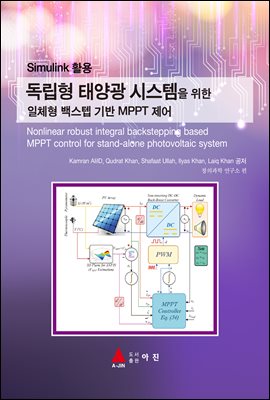
Simulink 활용 독립형 태양광 시스템을 위한 일체형 백스텝 기반 MPPT 제어
- 저자Kamran AliID, Qudrat Khan, Shafaat Ullah, Ilyas Khan, Laiq Khan 저
- 출판사아진
- 출판일2020-07-14
- 등록일2020-12-21
- SNS공유


- 파일포맷PDF
- 파일크기30MB
- 공급사YES24
-
지원기기
PC
PHONE
TABLET
프로그램 수동설치
전자책 프로그램 수동설치 안내
아이폰, 아이패드, 안드로이드폰, 태블릿,
보유 1, 대출 0,
예약 0, 누적대출 8, 누적예약 0
책소개
PV (Photovoltaic) cells have nonlinear current-voltage (I - V) and power-voltage(P - V) characteristics with a distinct maximum power point (MPP) that entirely
depends on the ambient meteorological conditions (i.e. solar irradiance and
temperature). Hence, to continuously extract and deliver the maximum possible
power from the PV system, under given meteorological conditions, the maximum
power point tracking (MPPT) control strategy needs to be formulated that
continuously operates the PV system at its MPP. To achieve this goal, a hybrid
nonlinear, very fast and efficient MPPT control strategy, based on the robust
integral backstepping (RIB) control, is formulated in this research article. The
simulation testbed comprises a standalone PV array, a non-inverting buck-boost
(NIBB) DC-DC power converter, a purely resistive and a dynamic load (sound
system). The proposed MPPT control scheme consists of two loops, where the first
loop generates the real-time offline reference peak power voltage through an
adaptive neuro-fuzzy inference system (ANFIS) network, which is then utilized in
the second loop as a set-point value for generating a control signal and then
forcing the PV system to be operated at this set-point by continuously adjusting
the duty ratio of the power converter. This control strategy exhibits no overshoot,
fast convergence, good transient response, fast rising and settling times and
minimum output tracking error. The MATLAB/Simulink platform is used to test the
performance of the proposed MPPT strategy against varying meteorological
conditions, plant current and voltage faults and plant parametric uncertainties. To
validate the superiority of the proposed control strategy, a comparative analysis of
the proposed control strategy is presented with the nonlinear backstepping (B),
integral backstepping controller (IB) and conventional PID and P&O based MPPT
controllers.
목차
제 1편 : SIMULINK 기본편1.1 SIMULINK의 시작 1
블록의 연결 5
블록 파라미터의 설정 7
시뮬레이션 파라미터 (Configuration Parameters)의 설정 8
시뮬레이션의 수행 9
블록 파라미터의 표시 9
복수 데이터의 표시 11
2.2 동적 시뮬레이션 13
이차 미분방정식 17
선형 상태변수 모델 23
DC 모터의 시뮬레이션 24
함수 블록의 사용 29
차분방정식(difference equation)의 모델링 34
Subsystem(부시스템)의 구성 37
제 2편 : 연구논문
Nonlinear robust integral backstepping based MPPT control for
stand-alone photovoltaic system
1. Introduction 41
2. Significant contributions 42
3. Reference peak power voltage estimation through Adaptive
Neuro-Fuzzy Inference System (ANFIS) 44
4. Robust integral backstepping MPPT controller design 51
5. Simulation results and discussion 57
6. Conclusions and future research recommendations 69
7. References 69

















